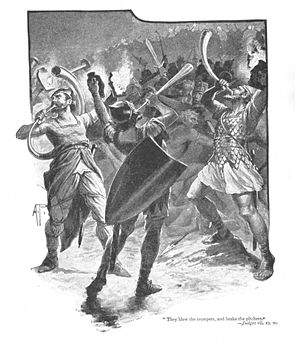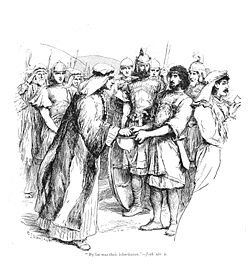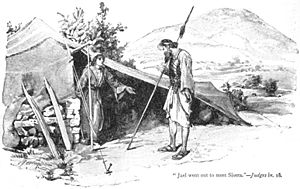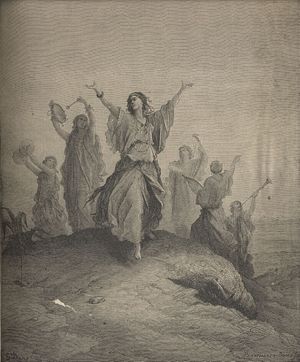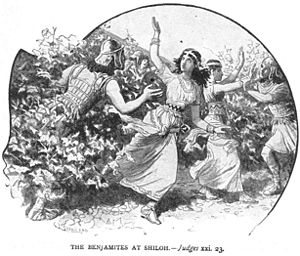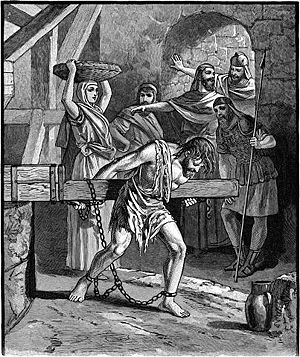Book of Judges
| Books of the |
| Judges in Bible |
|---|
| In the Book of Judges |
| Othniel |
| Ehud |
| Shamgar |
| Deborah |
| Gideon |
| Abimelech |
| Tola |
| Jair |
| Jephthah |
| Ibzan |
| Elon |
| Abdon |
| Samson |
| In the First Book of Samuel |
| Eli |
| Samuel |
The Book of Judges (Hebrew: Sefer Shofetim ◊°◊§◊® ◊©◊ē◊§◊ė◊ô◊Ě) refers to one of the books of the Hebrew Bible that is also included in the Christian Old Testament. It contains the history of the Biblical heroes known as "judges" (shofetim‚ÄĒchiefs‚ÄĒnot to be confused with modern judges), and of their times. It includes the stories of the famous heroes Samson and Gideon, as well as that of Deborah, one of the Bible's great women. It also tells the tragic tale of Jephthah, the warrior who sacrificed his only daughter as a burnt offering in fulfillment of a vow he made to God.
The book revolves around the legends of these five major judges and one shortlived king (Abimelech), with other minor judges listed only briefly. The stories concern leaders of the northern tribes, several of whom rose from a lowly status to lead their people, in the area which later became known as the Kingdom of Israel. Two stories at the end of the book do not deal with the judges themselves but with incidents that took place during this period: the migration of the tribe of Dan to its home in the north, and a war between Benjamin and the other tribes. The stories of two additional judges, Eli and Samuel, are told in the first of the Books of Samuel.
The Period of Judges
The biblical period of judges follows the story of Israel's exodus from Egypt and the conquest of Canaan under the leadership of Joshua. Therefore the period does not correspond exactly with that covered by the Book of Judges. It includes part of Joshua's time, plus the period of Eli and Samuel. Joshua, in this sense, can be considered the first of the judges. While the Book of Joshua paints a picture of the nearly complete conquest of Canaan by the Israelites under Joshua's leadership, the Book of Judges portrays the Israelites as only one of several peoples controlling various areas in the land. This view conforms more with the archaeological evidence, which sees little evidence of sudden conquest.
Traditionally, the judges are portrayed as having ruled over the whole of Israel. However, in reading the Book of Judges, it is clear that this occurred only occasionally. Their influence usually did not extend beyond the bounds of their own tribe and possibly a neighboring tribe or two. Nor should they necessarily be thought of as having ruled sequentially. Rather, some may have been active at the same time in different areas, with a later editor placing their stories in their current order and adding the details about the length of their reigns. The consensus of scholarly opinion now dates the period of the Judges to roughly 1200-1050 B.C.E.
Only a few of the "judges" are described as engaging in judicial activities. They were primarily warriors. Some were also prophets or priests. The last judge, Samuel, combined all of the above-mentioned functions and is credited with uniting the tribes of Israel into a national federation with its own king. The figure of Abimelech, son of Gideon, represents a type of anti-judge. He may have originally been included among the Great Judges, but in its current form, the Book of Judges considers him to be evil and thus not counted in their number.
Although 12 judges are listed in the Book, only five are dealt with in detail‚ÄĒthe so-called "Great Judges." The Book also contains an appendix of two stories dealing with inter-tribal relations. The first explains how the tribe of Dan came to the area of Laish and set up its particular form of Yahweh worship there. The second deals with a major war between the tribe of Benjamin and the other Israelite tribes.
The period of judges continues through the ministries of Eli and Samuel. Here, the judges play strong priestly and prophetic roles as well as military and regulatory ones. The period comes to an end with the crowing of King Saul by Samuel. However, Samuel's role as prophet and judge continues through his rejection of Saul and anointing of David in his place.
Summary of the Book
Introduction
The Book begins with an introduction that serves to update the reader of events after the close of the Book of Joshua and provides a theological perspective on the history of the period. Rather than driving out all of the Canaanites as they were supposed to, the Israelite have been unable, or unwilling, to take a good deal of the land. Several victories are noted, but also some failures. The major settlements of Meggiddo and Beth Shan remain unconquered. Canaanites and Israelites live together in relative peace in the towns of Sidon, Acco, Kitron, Gezer, and others. We learn later that the fortress city of Jerusalem, which the Book of Joshua claims was formerly taken, is not in Israelite hands.
Moreover, a new generation had grown up since Joshua's passing, "who knew neither the Lord nor what he had done for Israel" (2:11). God punished these Israelites by allowing raiders to plunder their towns and villages and making their tribes subject to foreign rulers. When they resisted this oppression, "The Lord's hand was against them." The biblical writer then explains that God raised up the judges to save them. He concludes the introduction, however, with a condemnation: "When(ever) the judge died, the people returned to ways even more corrupt than those of their fathers, following other gods and serving and worshiping them. They refused to give up their evil practices and stubborn ways." (2:19)
Overview of the Judges
Following the introduction, the Book of Judges proceeds to describe the central figures during this period of Israel's history. The text offers an overview of the main judges who are identified as follows:
- Othniel‚ÄĒWon renown by taking the town of Debir and marrying the daughter of Caleb, Joshua's lieutenant. The information about Othniel (Judges 1:11-15) appears to have been taken from its earlier mention in Joshua 15:15-19.
- Ehud‚ÄĒA left-handed Benjaminite, who, when sent on a mission to bring tribute to the King of Moab, assassinated him with a hidden sword. He then led the Israelites against Moab, reportedly killing 10,000 Moabites and making the nation a tributary of Israel.
- Shamgar‚ÄĒKilled six hundred Philistines with an ox goad.
- Deborah‚ÄĒA prophetess, and the only female judge. Headquartered between Bethel and Ramah, she challenged the overlordship of a Canaanite king called Jabin and his military commander Sisera. Her general, Barak, attacks the enemy, but it is a female assassin named Jael who turns out to be the real hero in this battle. The lengthy poem known as the "Song of Deborah" commemorates the event and is considered one of the most ancient parts of the Bible.
- Gideon‚ÄĒAn unlikely choice for a hero, the reticent Gideon came from a family of Baal worshipers from the tribe of Manasseh. He brought glory to God by winning a miraculous victory over the Midianites with only a small force. The first judge to rise to truly national prominence, he is said to have sired seventy sons through many wives. Gideon wisely turned down the kingship, an institution apparently disapproved of by God during this period. However, in an act reminiscent of Aaron's creation of the golden calf, he also fashioned for himself a golden ephod (sacred breastplate) which reportedly became an object of idolatrous adoration in his hometown of Orphah.
- Abimelech‚ÄĒThe anti-judge who would be king, Abimelech was Gideon's son through a concubine. When none of Gideon's legitimate sons assumed leadership after his death, Abimelech mounted a rebellion, slaying all but one of Gideon's heirs. He was then crowned king in Shechem. The Bible reports that he governed Israel as king for three years. Although he is given a full chapter in the Book, the biblical editors clearly disapprove of him. He is thus not counted among the true judges.
- Tola‚ÄĒOf him little is said except that he governed for 20 years in the hill country of Ephraim after the death of Abimelech.
- Jair‚ÄĒRuled in the area of Gilead with his 30 sons as lieutenants.
- Jephthah‚ÄĒA tragic figure, Jephthah was the son of a prostitute who rose to power by leading the Gileadites in battle against the Ammonites. With the Holy Spirit upon him, Jephthah vowed to sacrifice "whatever comes first out of my house" upon his return if God would give him victory. Jephthah won a decisive battle, but when he returned to his home in Mizpah, it was his only daughter who greeted him with an ironically joyous victory dance. Unlike in the story of Abraham's binding of Isaac, there is no last-minute reprieve for Jephthah's daughter. After her sacrifice, Jephthah became embroiled in an inter-tribal war against the Emphraimites, who had refused to join him in battle against Ammon and denigrated the Gileadites as a renegades. His reign lasted six years.
- Ibzan‚ÄĒA man of Bethlehem who had 30 sons as well as 30 daughters, and ruled for seven years.
- Elon‚ÄĒA Zebulunite who ruled for ten years.
- Abdon‚ÄĒRuled eight years and had 40 sons.
- Samson‚ÄĒThe most famous judge, but certainly not the most successful. Hailing from the tribe of Dan, Samson's birth was miraculous; and he had amazing physical powers related to his keeping of the Narzarite vow to avoid strong drink and never cut his hair or beard. Against his parents' will, he married a Philistine woman, but slew thirty of her kinsmen at their wedding party after she revealed the secret of a riddle he had posed. The father of the bride then gave her to another. Samson retaliated by burning the Philistines' fields. The Philistines avenged this act by killing Samson's beloved, prompting Samson to further violence. Later he slew a thousand of them single-handed with the jaw of an ass. These exploits displayed his great strength but also his fatal weakness for untrustworthy women. In the final episode, it is the beautiful Delilah who betrays him to his enemies. With his hair cut and his powers gone, the Philistines take him captive and put out his eyes. Samson's revenge‚ÄĒdestroying the temple of the Philistine god Dagon‚ÄĒkilled many Philistines, but did nothing to liberate his people. He judgeship is said to have lasted 20 years.
The Appendices
Two intriguing stories are appended to the those relating to the twelve judges.
In the first (ch. 17-18), a wealthy Ephraimite named Micah creates several valuable sacred objects and hires a Levite to serve as seer/priest in his household. A large group of migrating Danite tribesmen, however, persuade the Levite to join them, taking the artifacts with them. They succeed in conquering the territory of Laish, later called Dan, and set up a tribal sanctuary there. In verse 30, possibly representing a different version of the story, the priest of the Danites is identified as Moses' grandson, Johnathan. The story serves both to explain the origins of the Danite priesthood and to denigrate the Danite shrine as idolatrous.
The second is a story of another Levite and his concubine, whose murder results in a civil war. In a scene uncannily similar to the story of Lot's visitors in Sodom, the men of the area, who are Benjaminites, demand that the Levite be brought out to them so that they can "know" him (sexually). The Levite's host offers the men his own virgin daughter and the Levite's concubine instead, and the mob ends up settling for the Levite's concubine. They brutally rape and torture her, and the next morning her husband discovers her dead.
He returns home and divides her body in 12 pieces, sending one to each of the Israelite tribes, in a grisly call to national vengeance. The other tribes join in a bloody war against Benjamin. The Benjaminites initially prevail, but the Israelites ultimately gain the upper hand. After the battle, the Israelites solemnly vow not to intermarry with the Benjaminites. Later realizing that all twelve tribes must survive, however, they decide to provide wives for the remaining Benjaminites without breaking their vow. Two versions are related of how this was accomplished. In the first, the Israelites massacre the adult citizens of Jabesh-Gilead‚ÄĒwho refused to participate in the war‚ÄĒand force their daughters to marry Benjaminite men. In the second, the Israelites instruct the Benjaminites to kidnap wives from among the girls participating in the spring festival at Shiloh.
The Book concludes with an editorial comment that is repeated four times during the narrative: "In those days Israel had no king; everyone did as he saw fit." (See Judges 17:6, 18:1, 19:1, 21:25.)
Authorship and Textual Criticism
While the authorship of Judges has traditionally been ascribed to Samuel, the great majority of modern scholars have come to a much more complex conclusion. There is evidence of more than one literary source within some of the major stories, such as the insertion of the Song of Deborah into the narrative and the two explanations of how the Benjaminites obtained wives after their war with the other tribes. Many believe each of the Great Judges' stories once stood on its own and was later woven into one longer narrative. Language marking the transition from one story to another displays a later perspective that is implied in the stories themselves, speaking, for example, of why a certain custom persists "to this day" and mentioning that "in those days Israel had no king." The following is a more detailed examination of the process:
Introduction. The majority of critical scholars believe that 2:6-3:7 was the original introduction by the Deuteronomist, who wove together and edited the earlier stories in accord with his viewpoint of providential history. The first part of the introduction (1:1-2:5) is thought to be a late addition to the text, added sometime after the Deuteronomist version (7th or 6th c.) was constructed. Some passages (1:12-15, 2:6-9 and 3:7-11) are almost identical to ones in the Book of Joshua.
Main Text. The main text is believed to contain further compositional structure. The Deuteronomist is believed to have combined together six earlier separate texts, one for each of the original Great Judges, among whom Abimelech was once included. That Abimelech was once so regarded in supported by the fact that Samaritans still recognize him as a true king. (On the other hand, they reject Eli and Samuel as false priests who instituted a false kingship in Israel and Judah.)
The text is believed to have been further altered by the addition of passages concerning Minor Judges (10:1-5 and 12:8-15) in order to make the total number of Judges add up to 12. The addition of 3:31, placing in insignificant Shamgar in the list of Judges, is thought to compensate for the fact Abimelech could not be counted among the twelve.
Three of stories contain partly duplicate accounts: that of Deborah, Gideon, and the Benjaminite wives. The parable of Jotham (9:7b-20), is thought to be a later addition into the original tale of Abimelech, inserted to challenge his legitimacy. The parable itself, however, may have had an early origin.
In addition, the Samson narrative (13-16) contains two distinct cycles. The first is a tableaux concerning his romance of an unnamed Philistine woman and subsequent problems arising from it. The second is the tale of his relationship with Delilah, which begins with him standing between two gateposts at dawn, and ends with him standing between two temple pillars in the evening. It is debated whether these two cycles were collected separately from each other or originated from one author.
In addition to such parallel narratives, the story of Jephthah (11:1-12:7) is often suspected to have been subject to later editing in three locations, though the reasons for the first two are not at all clear:
- According to 11:1-2, it is Jephthah's own brothers that expelled him, whereas according to 11:7 it is the elders of Gilead.
- The message to the Ammonites at 11:12-27 is written as if directed at Moabites.
- 11:35-40 has the appearance of abridging a more extensive original text, glossing over the existence in the text of a tradition of human sacrifice to Yahweh, which is mentioned fairly obviously at 11:31.
Appendices. The appendices cover two stories from the time of the judges, but say nothing of the judges themselves. They also seem to cover events occurring at the beginning of the period of judges rather than at its end. Moreover, the narrative preceding the appendices continues smoothly if one skips to 1 Samuel, implying that the appendices have been inserted by a later editor.
The story of Micah and his Idols (17-18) is thought by some scholars to be composed from two distinct accounts. Whether or not this is true, the story is notable in so far that it describes a cult and priesthood at Dan which is mentioned nowhere else in the entire Hebrew Bible.
The story concerning the Levite and his concubine (19-21), is notable in that its main characters are not named, leading some to speculate that it is fiction. Others speculate that it may actually relate not to the period of judges, but to the ruining of the tribe of Benjamin by the war between David and the house of Saul. Some have also argued that the brief Book of Ruth was once part of the appendix of Judges (or its source), owing to its style, linguistic features and setting.
ReferencesISBN links support NWE through referral fees
- "Book of Judges" in the Jewish Encyclopedia, JewishEncyclopedia.com, 2001. Retrieved March 31, 2008.
- Matthews, Victor J. Judges and Ruth. Cambridge University Press, 2004. ISBN 9780521000666
- Smith, R. Houston. "The Book of Judges," in The Interpreters One-Volume Commentary on the Bible. Abingdon Press, 1984. ISBN 0687192994
- Schneider, Tammi J. Judges: Studies in Hebrew Narrative and Poetry. Liturgical Press, 2000. ISBN 9780814650509
External links
All links retrieved November 18, 2023.
- Shoftim - Judges (Judaica Press) ‚Äď translation with Rashi's commentary
- Judges at Bible Gateway (Various versions)
| |||||||||||||||||
Credits
New World Encyclopedia writers and editors rewrote and completed the Wikipedia article in accordance with New World Encyclopedia standards. This article abides by terms of the Creative Commons CC-by-sa 3.0 License (CC-by-sa), which may be used and disseminated with proper attribution. Credit is due under the terms of this license that can reference both the New World Encyclopedia contributors and the selfless volunteer contributors of the Wikimedia Foundation. To cite this article click here for a list of acceptable citing formats.The history of earlier contributions by wikipedians is accessible to researchers here:
The history of this article since it was imported to New World Encyclopedia:
Note: Some restrictions may apply to use of individual images which are separately licensed.
